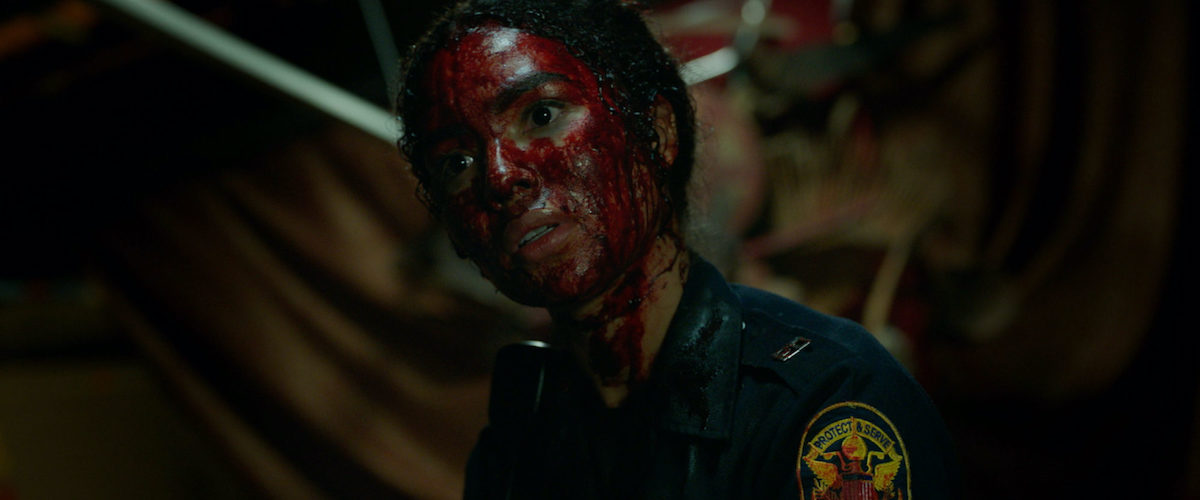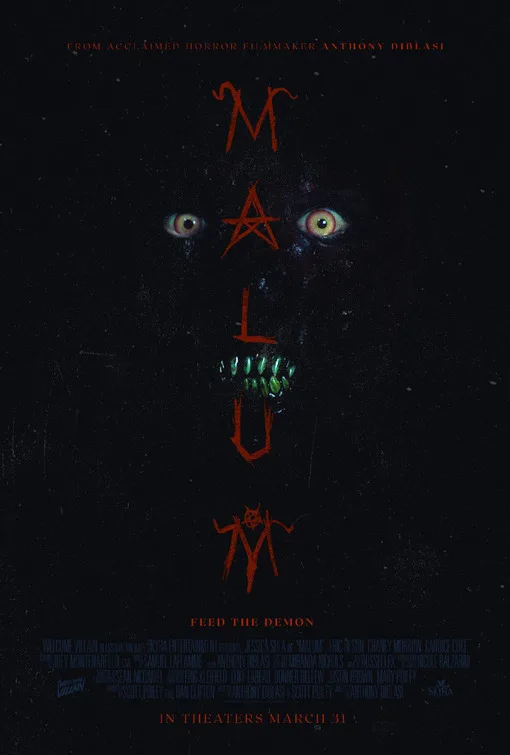“Malum,” about a rookie policewoman besieged by terrifying incidents during her first night on the job, is a low-budget horror movie where the filmmaking is the star.
Jessica Sula stars as Jessica Lauren, whose dad, Will (Eric Olson), was also a cop. Will died exactly one year ago tonight, shortly after participating in a raid on a compound full of cultists who worshipped a demon and killed people to feed his power. It’s said that Jessica’s father perished by his own hand after shooting several of his colleagues to death in the same station where Jessica now stands watch. Supposedly he snapped because he saved three women during the raid but blamed himself for failing to save a fourth.
Of course, there’s more to it than that, and the movie unpacks the rest of the (buried) details in due course. Daddy’s grotesque and tragic backstory, plus rampant police department sexism, explains why everyone on the force treats Jessica with either condescension or contempt and doesn’t take her seriously when she calls to tell them she’s getting prank phone calls from women threatening to “kill the pigs,” and that a large, long-haired homeless man has gotten into the station and is tearing the place up, and that somebody brought a gigantic hog with a stylized pentagram painted on its back to the front entrance of the building and tied it up. Cultists, cult sympathizers, and parasitic chaos agents are out on the streets stirring up trouble on the first anniversary, and we hear reports (via Jessica’s phone and radio conversations) that the police force can’t trace her prank phone callers or immediately send backup because they’ve got their hands full preventing the town from spiraling into mayhem.
How much do you really want to know about the rest of the plot? I think it’s wiser with a film like this to surrender to the experience, knowing in advance that “Malum” isn’t merely a haunted house movie but an experience that’s like paying to go into a “haunted house” for kicks on Halloween. The movie takes its sweet time building to the commercially mandated jump scares, CGI blood plumes, and impressionist glimpses of mutilated faces and limbs (by RussellFX, whose sculptors must moonlight at the morgue). Once that phase of the movie kicks in, “Malum” becomes a dark labyrinth in a rented entertainment space where gruesome things periodically pop out at you, screeching and yowling, and there’s blood on the walls, and the handful of working lights flicker drastically enough to create strobe-like effects, and you keep hearing a chorus of young women faintly singing a very old song, and hellish apparitions trudge out of the gloom and announce that they feast on angel’s wings. Is Jessica seeing actual things, or is she losing her mind? The film keeps teasing that binary all the way to the end, then gives you a different, more interesting answer.
The jump scares work (jump scares almost always do; they’re the easiest way to convince the audience that they’ve gotten their money’s worth), but “Malum” is much more impressive when it turns its talented ensemble cast loose on material that was obviously a lot of fun to play with. What actor doesn’t want to do a police interrogation where they get to lovingly recount the details of ritual sacrifice, pop their eyes, writhe around, and giggle? Or—as Chaney Morrow gets to do in the role of cult leader John Malum—look right into the camera and try to put the fear of hell in the viewer?
Director/co-writer/editor Anthony DiBlasi, a protege of Clive Barker, has mashed together two classic John Carpenter movies, “Assault on Precinct 13” and “Prince of Darkness,” added a burbling, “Satan is coming, try to look busy” synth score (by Samuel Laflamme, what a name) and then stirred in a lot of contemporary stylistic tics, including flash-cut gore with dissonant sound effects, and an extended action sequence in a darkly lit series of corridors that often adopts the rear-view, over-the-shoulder angle of a “shooter” video game.
The final third is, in terms of story, the least impressive section—it becomes increasingly narratively incoherent and chop-chop in the editing—but it’s also the most virtuosic in terms of compositions, camera movement, and physical acting. After a certain point, nothing in it scared me anymore because I was too enraptured by how much the filmmakers and actors were able to do with one location, lurid borderline-giallo cinematography (by Sean McDaniel, a name to watch), Laflamme’s music, and a smart use of whatever effects budget they had (most of it seems to have gone into the demon, and if so, great accounting decision: it’s magnificent).
If you care about indie horror trivia, here’s a fun bit: “Malum” is a remake of an earlier DiBlasi film, 2014’s “Last Shift,” which has the same basic plot—a rookie policewoman guards an abandoned police station, a year after an incident that entangled police officers with demonic cultists. DiBlasi and co-producer/co-writer Scott Poiley decided to do it again with more money and make it different. The main story change is having the heroine volunteer for duty at the station where her father died in order to gain access to his locker, check out the facility, and otherwise try to get answers to questions that are keeping her up at night; well, that and probably 200 times more overt supernatural stuff. The main style change is, er, everything. It’s a matter of energy, density, pacing, and scale, and this is even reflected in the music: the first one was defined by an acoustic guitar, while the second is wall-of-sound synth beats and chords that might liquefy your most recent meal if the speakers were loud enough.
A horror festival should consider screening both versions as a double feature, because the films are equally effective and fascinating to compare. The first is clearly a shoestring effort that relies on suggestion and spooky sound effects, has little gore and a clean, modern production design, waits 23 minutes to bring in score music, and keeps the story simple. The remake has a convoluted story that gets gradually and mostly verbally unpacked over 93 minutes; revels in its pre-World War II era, blue-tiled set; leans heavily on scoring from frame one; showcases its monster and gore effects with pride, and generally goes for a maximalist aesthetic. Both are equally valid ways to tell a story like this. That each is compelling in its own way makes me wish they’d try it a third time just to see what happens.
Now playing in theaters.




















